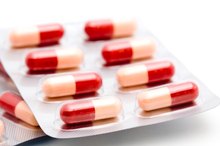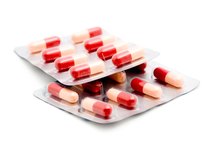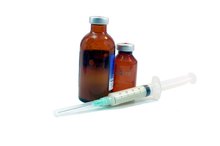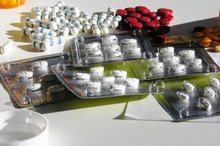What does fact checked mean?
At Healthfully, we strive to deliver objective content that is accurate and up-to-date. Our team periodically reviews articles in order to ensure content quality. The sources cited below consist of evidence from peer-reviewed journals, prominent medical organizations, academic associations, and government data.
The information contained on this site is for informational purposes only, and should not be used as a substitute for the advice of a professional health care provider. Please check with the appropriate physician regarding health questions and concerns. Although we strive to deliver accurate and up-to-date information, no guarantee to that effect is made.
Antibiotics to Treat Cystitis
Cystitis is the infection of the bladder, and according to Medline Plus, the symptoms of the disease include painful and frequent urination, fever, nausea and vomiting. MedlinePlus also reports that cystitis usually occurs in sexually active women between 20 to 50 years of age and is commonly caused by bacteria such as E. coli 1. Antibiotics are the mainstay of treatment against cystitis, therefore the type of antibiotic and length of treatment depend on the overall condition of the patient and the amount of bacteria in the urine.
If you are experiencing serious medical symptoms, seek emergency treatment immediately.
Amoxicillin
Traditionally, amoxicillin has been one of the most common antibiotics used to treat cystitis, but the University of Maryland Medical Center reports that 25 percent of E. coli strains are now resistant to this antibiotic. It can, however, be used to treat cystitis caused by Enterococcus species and Staphylococcus saprophyticus. Amoxicillin is available in capsule or tablet form and is taken orally every eight or 12 hours, as prescribed by the physician. Common side effects include nausea, vomiting and diarrhea, according to Merck Manuals Online Medical Library.
- Traditionally, amoxicillin has been one of the most common antibiotics used to treat cystitis, but the University of Maryland Medical Center reports that 25 percent of E. coli strains are now resistant to this antibiotic.
- Amoxicillin is available in capsule or tablet form and is taken orally every eight or 12 hours, as prescribed by the physician.
Cephalosporins
Antibiotics for Balanitis
Learn More
Cephalosporins such as cephalexin, cefadroxil, cefuroxime and cefixime are often used to treat cystitis and are effective against several different bacteria. These drugs may be administered orally or intravenously, depending on the condition of the patient. Merck Manuals Online Medical Library describes the common side effects of cephalosporins as diarrhea, vomiting and stomach cramps.
Fluoroquinolones
Another class of antibiotics that are widely used to treat cystitis are fluoroquinolones such as ciprofloxacin and norfloxacin. In a clinical trial published in the February 2005 edition of The Journal of the American Medical Association, Dr. Thomas M. Hooton reports that a three-day regimen of ciprofloxacin could cure 77 percent of the women with uncomplicated cystitis within two weeks 2.
Fluoroquinolones work by killing the bacteria that cause the infection and are available in capsule or tablet form to be taken orally. Nausea, vomiting, stomach pain and heartburn are the common side effects, as described by the Merck Manuals Online Medical Library .
- Another class of antibiotics that are widely used to treat cystitis are fluoroquinolones such as ciprofloxacin and norfloxacin.
Doxycycline
What Are the Treatments for Inflammation of the Urethra?
Learn More
Doxycycline is commonly prescribed to treat cystitis caused by chlamydia and mycoplasma species and is available in tablet and suspension form. The University of Maryland Medical Center warns pregnant women and children against the use of doxycyline. The common side effects include:
- changes in skin color
- sunburn
- sore mouth
- upset stomach
- diarrhea
- according to Merck Manuals Online Medical Library
Trimethoprim/Sulfamethoxazole
The Johns Hopkins Point of Care Information Technology Center recommends trimethoprim/sulfamethoxazole, or TMP/SMX, as the first-line treatment for uncomplicated cystitis because it is fairly effective and cheap 3. However, about 20 percent of E. coli strains that cause cystitis are resistant to this antibiotic in the United States and hence should be used cautiously. A three-day regimen of the antibiotic is administered orally and, according to the Merck Manuals Online Medical Library, common side effects include:
- nausea
- vomiting
- diarrhea
- loss of appetite
Nitrofurantoin
In an article published in the November 2007 edition of Archives of Internal Medicine, Dr. Kalpana Gupta recommends a five-day course of nitrofurantoin as an alternative to a three-day course of TMP/SMX to prevent further emergence of resistance to fluoroquinolones, which are used as an alternative in patients with TMP/SMX allergies 4. Nitrofurantoin is available as a capsule and liquid and is taken orally two or four times a day. Common side effects, as described by Merck Manuals Online Medical Library, include nausea, vomiting and loss of appetite.
- In an article published in the November 2007 edition of Archives of Internal Medicine, Dr. Kalpana Gupta recommends a five-day course of nitrofurantoin as an alternative to a three-day course of TMP/SMX to prevent further emergence of resistance to fluoroquinolones, which are used as an alternative in patients with TMP/SMX allergies 4.
Related Articles
References
- MedlinePlus: Cystitis: Acute
- "The Journal of American Medical Association"; Amoxicillin-Clavulanate vs. Ciprofloxacin for the Treatment of Uncomplicated Cystitis in Women; Thomas M. Hooton, Delia Scholes, Kalpana Gupta, Ann E. Stapleton, Pacita L. Roberts, Walter E. Stamm; February 2005
- Johns Hopkins Point of Center Information Technology: Bacterial Cystitis Acute, Uncomplicated
- "Archives of Internal Medicine"; Short-Course Nitrofurantoin for the Treatment of Acute Uncomplicated Cystitis in Women; Kalpana Gupta, Thomas M. Hooton, Pacita L. Roberts, Walter E. Stamm; November 2007
- Payne H, Adamson A, Bahl A, et al. Chemical- and radiation-induced haemorrhagic cystitis: current treatments and challenges. BJU Int. 2013;112(7):885-97. doi:10.1111/bju.12291
- Ayas M, Siddiqui K, Al-jefri A, et al. Factors affecting the outcome of related allogeneic hematopoietic cell transplantation in patients with Fanconi Anemia. Biol Blood Marrow Transplant. 2014;20(10):1599-603. doi:10.1016/j.bbmt.2014.06.016
- Liem X, Saad F, Delouya G. A practical approach to the management of radiation-induced hemorrhagic cystitis. Drugs. 2015;75(13):1471-82. doi:10.1007/s40265-015-0443-5
- Manikandan R, Kumar S, Dorairajan LN. Hemorrhagic cystitis: A challenge to the urologist. Indian J Urol. 2010;26(2):159-66. doi:10.4103/0970-1591.65380
- Ruggeri A, Roth-guepin G, Battipaglia G, et al. Incidence and risk factors for hemorrhagic cystitis in unmanipulated haploidentical transplant recipients. Transpl Infect Dis. 2015;17(6):822-30. doi:10.1111/tid.12455
- Riachy E, Krauel L, Rich BS, et al. Risk factors and predictors of severity score and complications of pediatric hemorrhagic cystitis. J Urol. 2014;191(1):186-92. doi:10.1016/j.juro.2013.08.007
- Cardinal J, Slade A, Mcfarland M, Keihani S, Hotaling JN, Myers JB. Scoping review and meta-analysis of hyperbaric oxygen therapy for radiation-induced hemorrhagic cystitis. Curr Urol Rep. 2018;19(6):38. doi:10.1007/s11934-018-0790-3
Writer Bio
A freelance writer and blogger since 2007, Shamala Pulugurtha's work has appeared in magazines such as the "Guide to Health and Healing" and prominent websites like Brain Blogger and NAMI California. Pulugurtha has a postgraduate degree in medical microbiology from Manipal Academy of Higher Education, India and has completed course work in psychology and health education.









